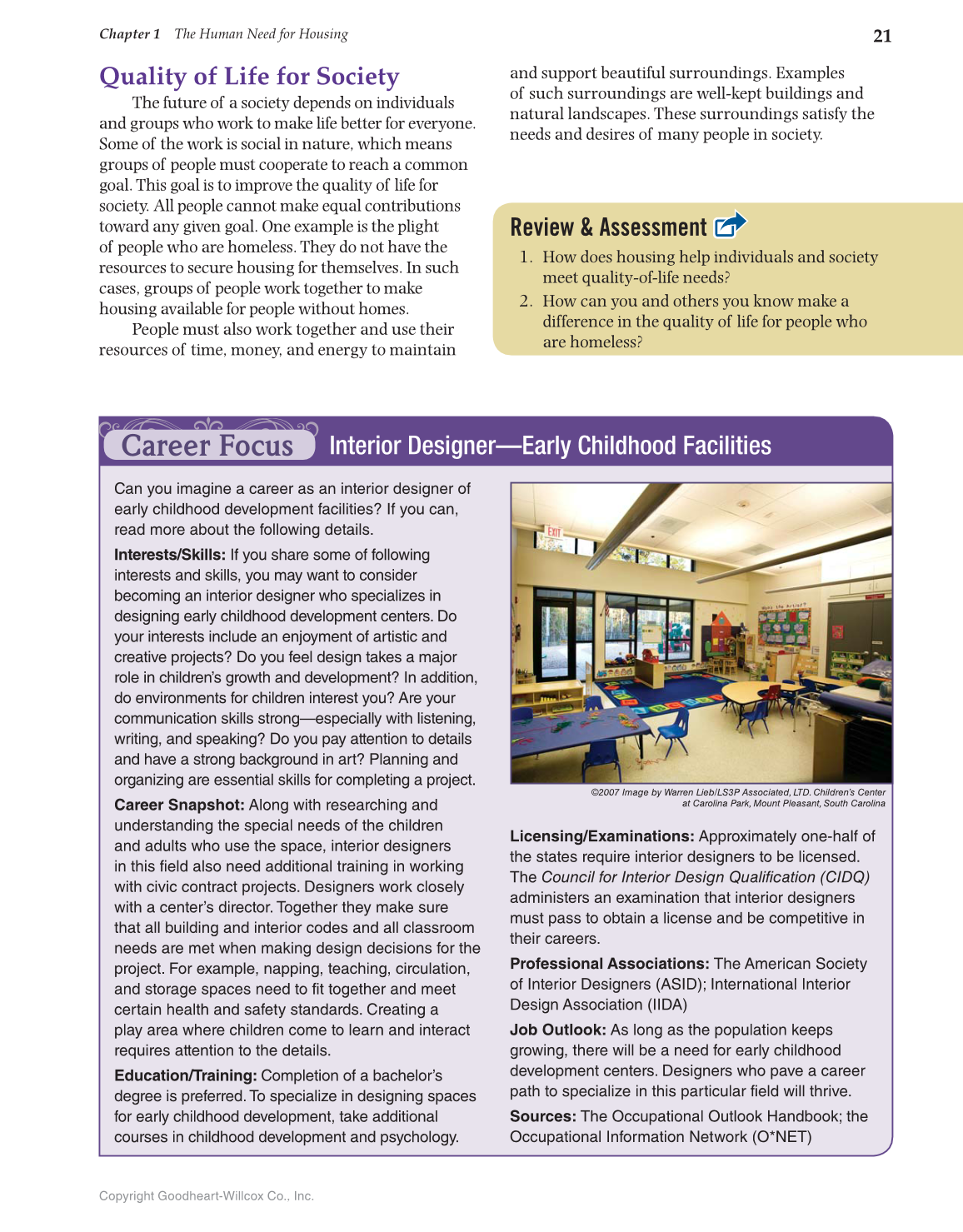21
Chapter 1 The Human Need for Housing
Copyright Goodheart-Willcox Co., Inc.
and support beautiful surroundings. Examples
of such surroundings are well-kept buildings and
natural landscapes. These surroundings satisfy the
needs and desires of many people in society.
Review & Assessment
1. How does housing help individuals and society
meet quality-of-life needs?
2. How can you and others you know make a
difference in the quality of life for people who
are homeless?
Quality of Life for Society
The future of a society depends on individuals
and groups who work to make life better for everyone.
Some of the work is social in nature, which means
groups of people must cooperate to reach a common
goal. This goal is to improve the quality of life for
society. All people cannot make equal contributions
toward any given goal. One example is the plight
of people who are homeless. They do not have the
resources to secure housing for themselves. In such
cases, groups of people work together to make
housing available for people without homes.
People must also work together and use their
resources of time, money, and energy to maintain
Interior Designer—Early Childhood Facilities
Can you imagine a career as an interior designer of
early childhood development facilities? If you can,
read more about the following details.
Interests/Skills: If you share some of following
interests and skills, you may want to consider
becoming an interior designer who specializes in
designing early childhood development centers. Do
your interests include an enjoyment of artistic and
creative projects? Do you feel design takes a major
role in children’s growth and development? In addition,
do environments for children interest you? Are your
communication skills strong—especially with listening,
writing, and speaking? Do you pay attention to details
and have a strong background in art? Planning and
organizing are essential skills for completing a project.
Career Snapshot: Along with researching and
understanding the special needs of the children
and adults who use the space, interior designers
in this field also need additional training in working
with civic contract projects. Designers work closely
with a center’s director. Together they make sure
that all building and interior codes and all classroom
needs are met when making design decisions for the
project. For example, napping, teaching, circulation,
and storage spaces need to fit together and meet
certain health and safety standards. Creating a
play area where children come to learn and interact
requires attention to the details.
Education/Training: Completion of a bachelor’s
degree is preferred. To specialize in designing spaces
for early childhood development, take additional
courses in childhood development and psychology.
Career Focus
©2007 Image by Warren Lieb/LS3P Associated, LTD. Children’s Center
at Carolina Park, Mount Pleasant, South Carolina
Licensing/Examinations: Approximately one-half of
the states require interior designers to be licensed.
The Council for Interior Design Qualification (CIDQ)
administers an examination that interior designers
must pass to obtain a license and be competitive in
their careers.
Professional Associations: The American Society
of Interior Designers (ASID); International Interior
Design Association (IIDA)
Job Outlook: As long as the population keeps
growing, there will be a need for early childhood
development centers. Designers who pave a career
path to specialize in this particular field will thrive.
Sources: The Occupational Outlook Handbook; the
Occupational Information Network (O*NET)
